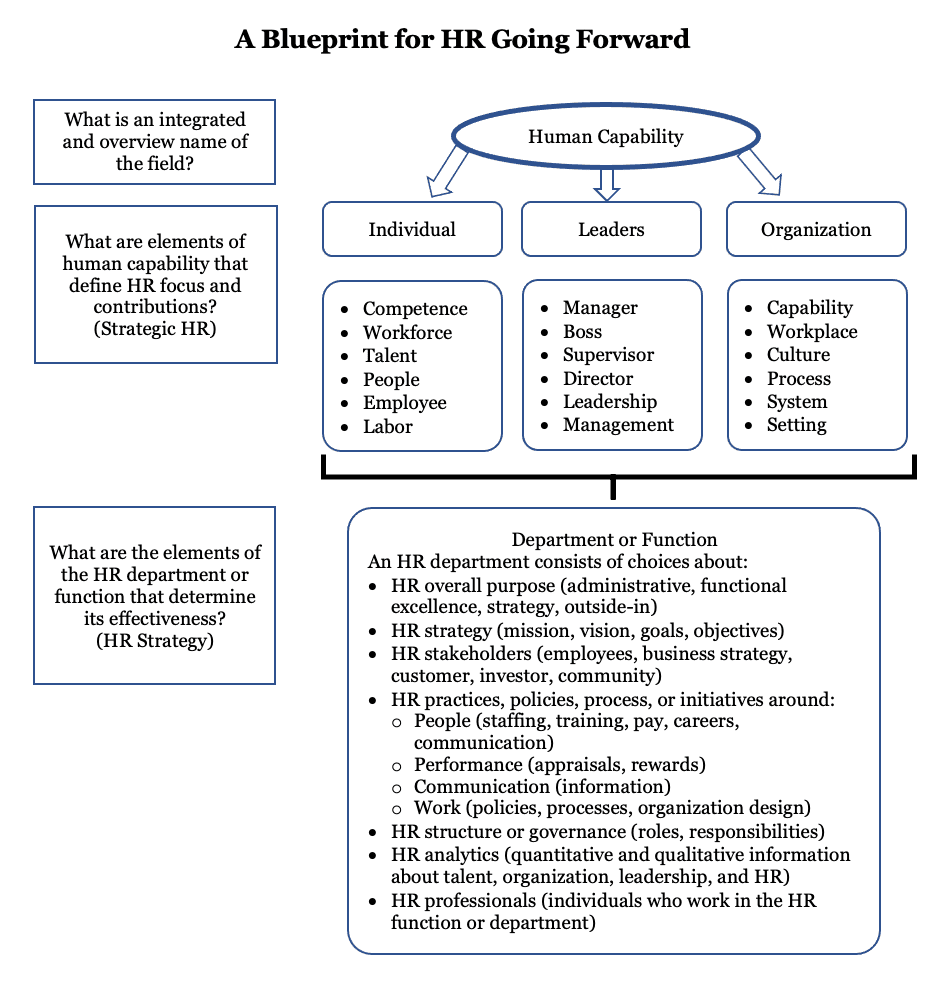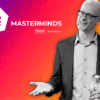
Dave Ulrich- Rensis Likert Professor of Business, Ross School of Business, University of Michigan
Words matter. They shape ideas that lead to action.
Words may vary (e.g., a strong windstorm goes by different names depending on location: hurricane, typhoon, gale, monsoon, whirlwind, tempest).
Words may have subtle differences depending on who defines and uses the terms (e.g., a firm’s direction may be called mission, vision, strategy, planning, aspiration, intent, agenda, purpose, goals, or objectives).
Too often in the human resource (“HR”) field (I will refer to legacy “HR” with this term and future HR without quotes), ambiguous and sometimes unclear words and concepts reduce the impact of “HR.”
Some Examples
What is the name of the field? While the terms industrial relations and personnel have been left behind some time ago, many ways exist to describe the work of “HR”: human capital management (Deloitte), people operations (Google and Uber), talent management, people (Facebook), employee experience (Airbnb), employee success (Salesforce), head of people, people resource center, employee relations, team member services, culture and talent management, and so forth.
What does “HR” work focus on, contribute, and deliver? Consistent with the mixed terms defining its work, “HR” often focuses on individuals and/or organizations with some of the following terms:
- Individuals: competence, people, employee, workforce, talent, labor
- Organizations: capability, process, system, workplace, team, setting
What does strategic “HR” refer to? [1] The “HR” implications of the business strategy. [2] The strategic direction of the HR department. [3] Both?
To accelerate the contribution of “HR” to stakeholder value, accepted terms help shape a shared blueprint for action. With conceptual clarity, engaging in dialogue about why “HR” exists, what “HR” delivers, and how to improve “HR” is much easier.
Having been actively involved in “HR” work for decades, I propose a simple yet comprehensive “term sheet” that may help clarify HR going forward and offer a shared blueprint for action as laid out in the figure below.

Clarification of These Terms and Blueprint
Human capability is not a new term (see the exceptional book by thought leader Elliot Jacques and Kathryn Cason as well Pat Wright’s bringing the term into “HR”). But I believe the term can and should evolve to integrate both the individual (human) and organizational (capability) elements of HR’s agenda. Many organizations narrowly define “HR”’s role as exclusively focused on individuals: human capital, employee experience, talent manager, people operations. Other companies have tried to broaden “HR” with “people and organization,” which reflects HR’s breadth of impact. “Human capability” captures this mix.
Individual, leaders, organization, and HR. Within the broad human capability work, four pathways for action branch out.
Individual focuses on the people, talent, employee, or workforce. People are the raw ingredients of any organization. They carry with them skills and attitudes that make up an organization. HR’s work is to help employees realize their potential, improving their competencies, and create positive experiences.
Organization focuses on how individuals come together to collectively work together to become more than their separate efforts. An organization may be defined less by its structure (morphology, hierarchy, roles) and more by the capabilities it possesses (what the organization is known for and good at doing). In psychology, individuals have physical and character traits that come together to form personality; likewise, organizations combine individual competencies into organization capabilities. HR’s work is to identify and develop the organization’s capabilities that deliver employee, strategic, customer, financial, and community results.
Leadership refers both to individual leaders at all levels of an organization and to the overall leadership capability (or leadership brand) of an organization. Leaders (individual competencies) and leadership (organization capability) shape both individual behavior as people do what their leaders do and organization processes as organization capabilities often reflect leaders’ competencies.
With these three contributions of human capability defined, strategic HR then refers to how any organization can invest in talent, leadership, and organization to deliver stakeholder results. Whenever HR is invited to a business discussion, the simple but profound question is: “What are the talent, leadership, and organization initiatives that will deliver targeted results?”
HR department or function focuses on the specific HR functional agenda. We have identified nine dimensions of an effective HR department that include the HR department’s purpose, customers, governance, practices, people, and working relationships. Improving these nine dimensions of HR will ensure an HR strategy that aligns with business strategy.
Implication of These Terms
With these four pathways for human capability articulated, the thousands of studies and actions of HR can be organized into one of the four pathways so those insights can cumulate and evolve. The Organization Guidance System (OGS) that we have crafted and tested offers a blueprint for how to upgrade human capability through talent (ten individual-focused initiatives), leadership (six leadership actions), organization (twelve organization capabilities), and HR department (nine domains of HR effectiveness). These 37 total human capability initiatives can then be prioritized on the extent to which they deliver employee, strategy, customer, financial, and community results.
The eighth round of the HR Competency study with over 27,000 global respondents and 18 HR Association Partners identifies what HR professionals should be, know, and do to be effective. The basic logic of these findings (to be released on May 11) is accelerating business through advancing human capabilities. Human capabilities, as defined in this essay, become the overall agenda to deliver on business results.
Any profession continually evolves from a haphazard set of experiences and ideas. I believe now is the time to continue to evolve the HR profession into a blueprint that can lead to even more value through a shared language that leads to action.
Will people continue to refer to this overall blueprint as HR? Certainly. But within this overall HR blueprint, we can separate human capability contributions in talent, leadership, and organization, and the HR department that enables these contributions.
………
Dave Ulrich is the Rensis Likert Professor at the Ross School of Business, University of Michigan, and a partner at The RBL Group, a consulting firm focused on helping organizations and leaders deliver value.
Written by: Dave Ulrich
Previous post

- 80
labelArticles today2022.02.09.
Rethinking what it means to be a great place to work through Mental health advocacy and workplace balance
Tami Wolownik, Head of People and Organization (P&O) – Siemens Mobility North America Mental health isn’t something worn on your sleeve and it’s not something everyone wants to talk about. But with honest and meaningful [...]
Similar posts

labelArticles today2024.10.21.
The success-recipe to build agile and future-ready organizations in 2025 and beyond








Post comments (0)